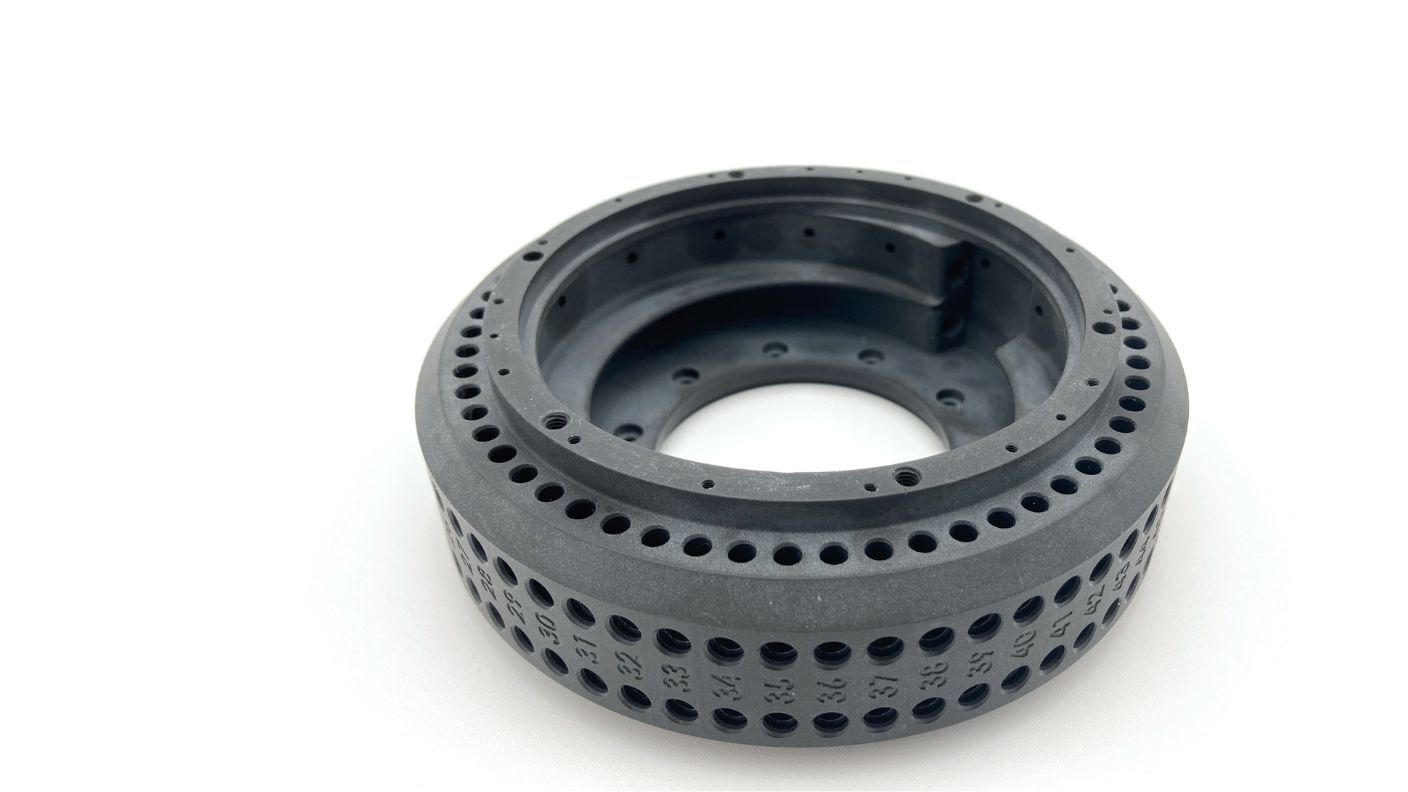The Monterey Bay Aquarium Research Institute (MBARI) is refining the integration of a unique biological sampling system in an autonomous underwater vehicle (AUV). The primary objective is to advance collection techniques that have the potential to streamline the work of biologists and resource managers.
Jim Birch, director of MBARI's SURF Center, contacted Sherpa to 3D print a fluid manifold part for the Environmental Sample Processor (ESP), a robotic lab that automates water sample collection and processing. This ESP can handle up to 60 samples. The part, a complex Toroid Ring with 60 dual ports, needed to be watertight, airtight, and capable of withstanding 500 psi without leaking.
 MBARI’s long-range autonomous underwater vehicle (LRAUV) equipped with a third-generation Environmental Sample Processor (3G ESP) during a deployment in Monterey Bay. Credit: © 2021 MBARI/Monterey Bay Aquarium
MBARI’s long-range autonomous underwater vehicle (LRAUV) equipped with a third-generation Environmental Sample Processor (3G ESP) during a deployment in Monterey Bay. Credit: © 2021 MBARI/Monterey Bay Aquarium
Previously, MBARI tried another 3D resin for this application; however, the material exhibited several shortcomings leading to poor performance and part failure:
- Excessive brittleness
- Inadequate performance in extreme temperatures
- Poor compatibility with their cleaning agent (water with 10% bleach).
To address these challenges, MBARI explored two alternatives:
- Investigating metal 3D printing, which was significantly more expensive.
- Utilizing the Carbon Digital Light Synthesis (DLS) polymer 3D printing.
In order to explore the Carbon DLS option, Dr. Birch sought a partner capable of managing both design and fabrication of this complicated part. He identified Sherpa via the Carbon website.
Initial Evaluation
Upon receiving the CAD files and reference drawings, it became evident that the complexity of the component (60 internal fluid passages and difficult-to-access threads) required 3D printing. Nevertheless, certain features required surface finishes and tolerances beyond the capabilities of 3D printing.
 MBARI Research Specialist Christina Preston preparing a third-generation Environmental Sample Processor (ESP) in a research lab inside MBARI’s Instrumentation Integration and Testing Facility. Credit: Todd Walsh © 2025 MBARI
MBARI Research Specialist Christina Preston preparing a third-generation Environmental Sample Processor (ESP) in a research lab inside MBARI’s Instrumentation Integration and Testing Facility. Credit: Todd Walsh © 2025 MBARI
We determined that post-CNC machining a Carbon 3D printed part would address this requirement, leveraging our in-house additive and subtractive manufacturing capabilities.

Carbon EPX 150
We began by examining their material requirements and ultimately, selected Carbon’s EPX 150 resin. We chose EPX 150 because it had great machinability and resistance to machining coolant. The data sheets showed great resistance to the ten percent bleach cleaning agent. They also show a lower rate of thermal expansion compared to the previous method.
| Thermal Properties | Test Standard | Metric | US |
| Coefficient of thermal expansion (-30, 50 °C) | ASTM E831 | 76*10-6 ppm/°C | 42*10-6 ppm/°F |
Disinfecting Solvents
For industrial and medical applications, EPX 150 is compatible with commonly used disinfecting chemicals and reagents showing no surface yellowing, no blemishes and with minimal change in tensile properties after chemical exposure to most of the solvents (except 70% ethanol/water when subjected to longer durations).

Treatment Method: Samples submerged in test liquid for 28 days at 23 °C then removed from test liquid and washed with DI water.
Test Method: ASTM D638, Type V, 1 mm/min
A trial part was printed and subjected to manual milling to evaluate feasibility, which successfully demonstrated proof of concept.
DfAM for Post Machining Tolerances
After meetings between MBARI and Sherpa Design’s manufacturing leads, we determined which features could be produced with Carbon printing alone and which needed additional 5-axis CNC machining.
First, we conducted a series of test printing, measurement, and scaling compensations to get the 3D printed features within tolerance. Next, we put our focus on features that required machining tolerances. Programming the part required a series of drilling, reaming, and T-slot cutting to maintain concentricity of the fluid ports. After continued iteration, we revised the CAD model by adjusting some preexisting features and eliminating others.
| Key process insights included: |
| Machine features that require tight tolerances and concentricity. |
| Adding Machine Stock: Adding excess material to facilitate subsequent machining. |
Tolerances
In general, if the part specification requires tolerances tighter than ISO-2768-m, then we employ CNC machining; for looser tolerances, 3D printing alone may suffice.
Adding Machine Stock
It was necessary to print the component with greater material allowance than anticipated to ensure complete cleanup during machining. Adding machine stock provided sufficient material for more extensive machining than originally planned.

This shifted the manufacturing split from approximately 95% 3D printing to 75%, with the remainder reliant on CNC finishing.
Conclusions
“Achieving such solutions efficiently required close collaboration between our additive specialists and our CNC machinist—a unique advantage of working with Sherpa as a Carbon Partner,” noted Pat Barrett, Owner, Sherpa.
The component met all client-specified tolerances, and feedback regarding finish and quality was highly positive. It passed rigorous testing at MBARI, including static pressure testing up to 500 psi.
The part is currently deployed in the ESP and undergoing field trials in MBARI’s long-range autonomous underwater vehicle (LRAUV).

MBARI researchers and collaborators from NOAA deploy a long-range autonomous underwater vehicle (LRAUV) equipped with a third-generation Environmental Sample Processor (3G ESP) in Lake Erie. Credit: Jim Birch © 2019 MBARI
“MBARI's innovative scientific instruments are transforming our ability to monitor the health of aquatic ecosystems. The team at Sherpa helped create a custom component that will ensure our technology can gather much-needed environmental data even in challenging ocean conditions."
James M Birch, Ph.D.
Director, SURF Center
Monterey Bay Aquarium Research Institute (MBARI)

